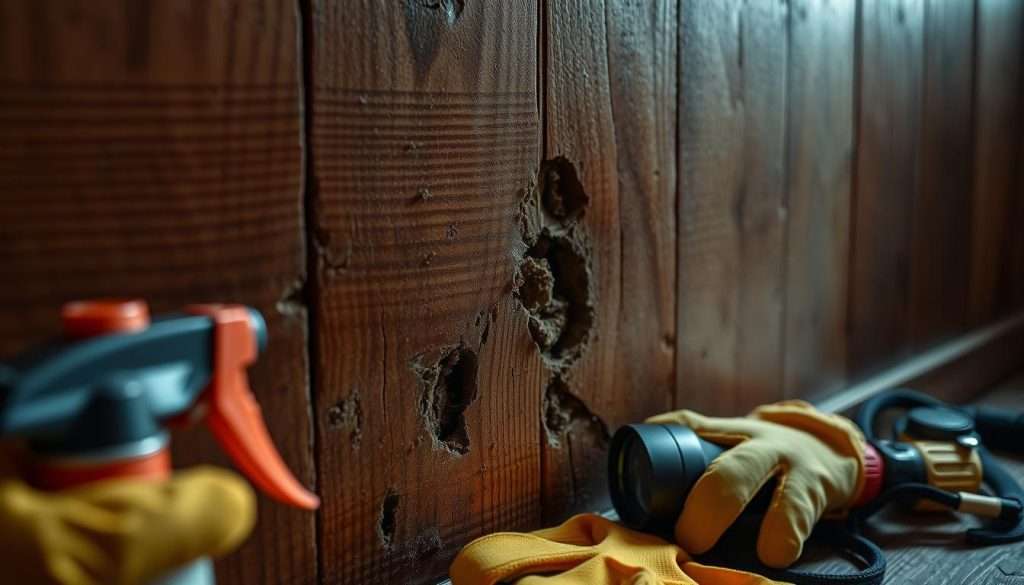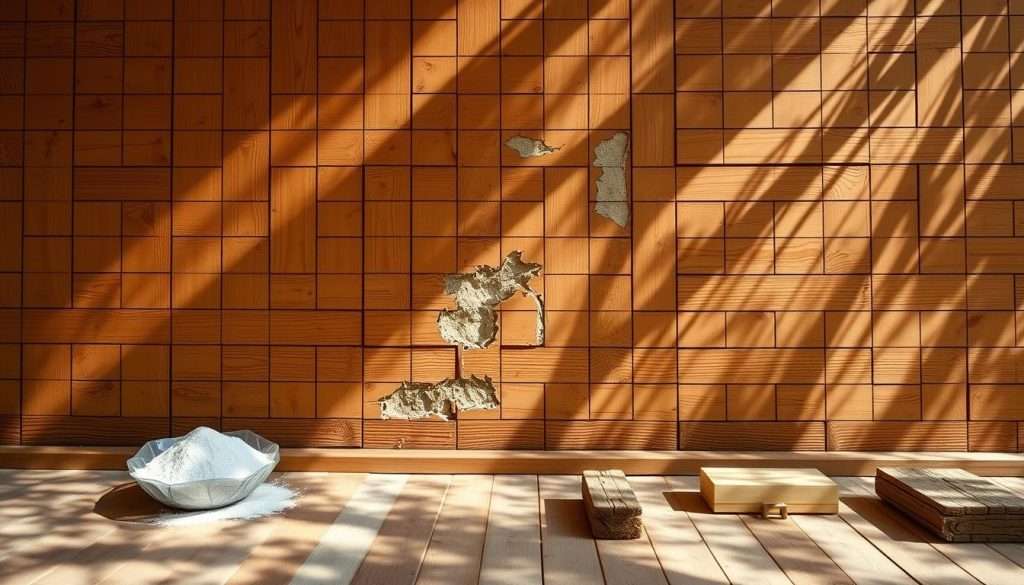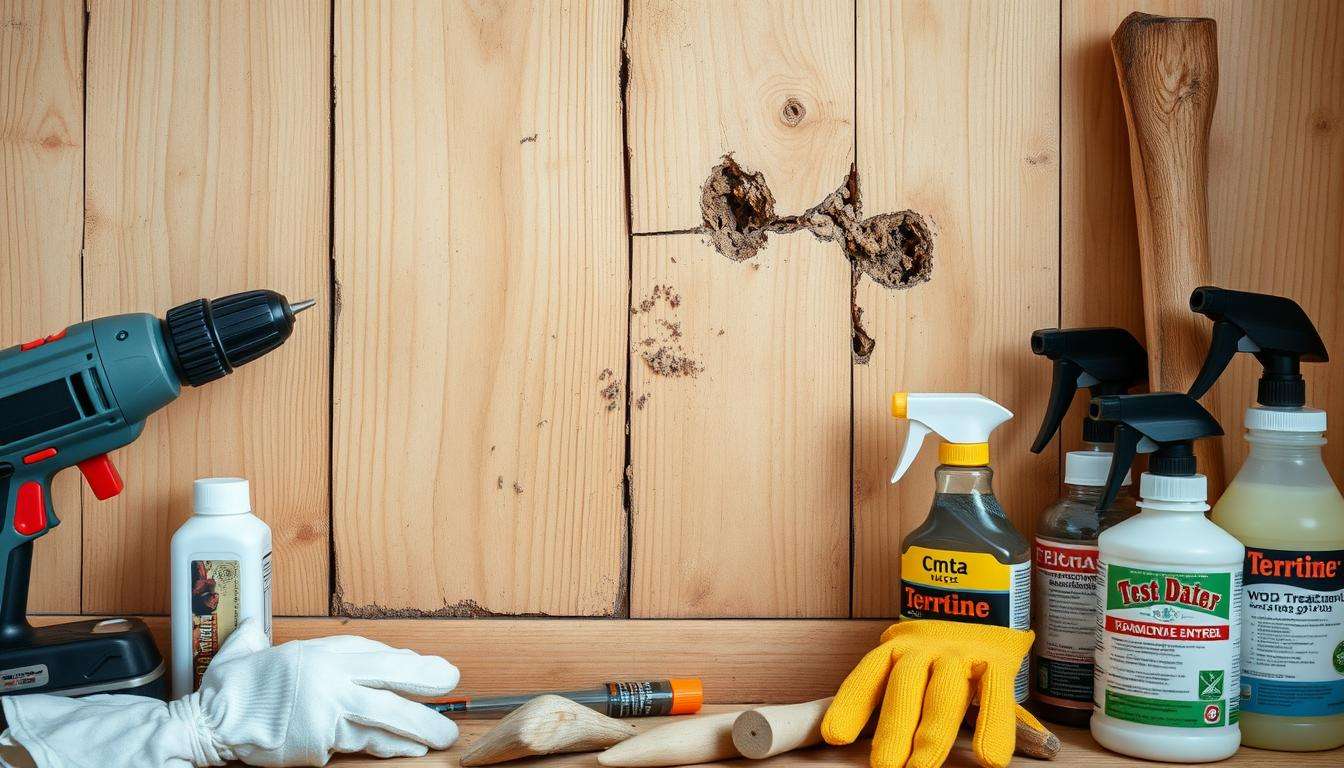Welcome to our guide on killing termites in walls. If you own a home or like to DIY, dealing with termites is key. Termites damage $30 billion worth of homes each year in the U.S. So, knowing how to control them is vital.
This guide will teach you how to spot, treat, and stop termites. You’ll get clear steps and expert advice. This way, you can keep your home safe and sound.
Key Takeaways
- Understand the three primary types of termites: subterranean, drywood, and dampwood.
- Identify signs of infestation, including hollow-sounding wood and mud channels.
- Choose proper treatment options, like liquid termiticides or bait systems.
- Implement preventive measures to minimize future infestations.
- Regular inspections can help catch termite activity early.
Understanding Termite Infestations
It’s key to know about termites and their signs to protect your home. This knowledge helps you act fast against termites before they cause big damage.
Types of Termites That Affect Your Walls
Many termite types can harm wooden parts of your home in different ways. Here are the main ones:
- Subterranean Termites: They live underground and build mud tubes on walls. These tubes help them move between their homes and food.
- Drywood Termites: These termites live inside the wood they eat. They don’t need soil. Finding them early is hard because they grow slowly.
- Dampwood Termites: They like moist wood and are found in damp places. They eat wood that’s rotting or wet.
Signs of Termite Activity in Your Home
Spotting termite signs is key to stopping big damage. Look for these signs:
- See mud tubes on walls? Termites use them to travel safely.
- Wood that sounds hollow when tapped might have termites inside.
- Cracks or bubbles in paint could mean termites are making it wet.
- Termite droppings, like sawdust, near wood are a sign of termites.
- Small holes in wood, about 1/8 inch, show termites are there.
Knowing these signs lets you act quickly. If you ignore them, termites can damage your walls and wood badly.
How to Kill Termites in Wall
First, you need to know how bad the termite problem is. Before you start killing termites, find out how many there are in your walls. This will help you pick the best way to treat them.
Identifying the Extent of the Infestation
To see how bad it is, you should check your house well. Here’s how:
- Use a flashlight to look for damage on wood.
- Use tools like a screwdriver to find soft spots in wood.
- Check crawl spaces and hidden spots for mud tubes, which are very small.
- Look for discarded wings, which mean termites are there.
Knowing how many termites you have is key. A small group can have 60,000 termites. A big nest can have up to a million. This helps you know how to get rid of them.
Choosing the Right Treatment Method
After you know how bad it is, you need to pick a treatment. There are many ways to kill termites, including chemicals and non-chemical methods:
- Chemical Treatments: Insecticides like imidacloprid or fipronil work well in soil. You can also use foam or dust in hard-to-reach places.
- Non-Chemical Approaches: The Sentricon® baiting system kills termites by targeting the queen. This leads to getting rid of the whole colony.
DIY methods like boric acid, diatomaceous earth, or cardboard traps can also work. But, using only DIY methods might not get rid of all termites. This is because big colonies keep making more termites.

DIY Termite Treatment Methods
Homeowners facing termite issues have several effective DIY options available. Understanding these methods can empower you to tackle infestations head-on.
Using Liquid Termiticides
Liquid termiticides are powerful allies in your DIY termite treatment arsenal. Products containing active ingredients like Fipronil and Imidicloprid can create a protective barrier that lasts for up to a decade. To apply, dig trenches around your home’s foundation and pour the diluted termiticide into the trenches. This method ensures that termites cannot breach the barrier and allows for effective coverage against both subterranean and drywood termites.
Termite Bait Systems
Termite bait systems offer a proactive solution to eliminate termite colonies. Place bait stations around the perimeter of your home. As termites consume the bait, they carry it back to their colonies, gradually eradicating the entire population. This method is particularly beneficial because it targets the problem at its source and can work effectively with other DIY termite treatment strategies.
Foams and Dust Treatments
For those hard-to-reach areas, foam treatments like Termidor Foam can fill voids and inaccessible spaces, providing a targeted approach to eliminate termites. These foam treatments can be especially effective in conjunction with other methods such as liquid termiticides or bait systems, enhancing overall effectiveness. Utilizing dust treatments in wall voids and structural cavities can further ensure that termites are not just pushed back but eliminated entirely.
For more detailed guidance on each treatment type, visit this resource. A balanced approach integrating different strategies can significantly improve your chances of effectively combating a termite infestation.
Preventing Future Termite Infestations
Getting rid of termites is just the first step. It’s important to keep them away for good. Use physical barriers, control moisture, and check your home often to stop termites from coming back.
Effective Termite Barrier Strategies
Stopping termites means using the right barriers. Here are some good options:
- Physical barriers: Use metal or plastic to block termites from getting in around your home’s base.
- Soil treatments: Put non-repellent termiticides in the soil. They work for over five years to keep termites away.
- Landscaping awareness: Don’t let mulch touch your home’s base. Make sure wood isn’t touching the ground.
Maintaining Proper Moisture Control
Keeping moisture levels down is key to stopping termites. Here’s how:
- Ventilation: Make sure basements and attics have good air flow to lower humidity.
- Repair leaks: Fix any leaks fast to keep your home dry.
- Gutters and drainage systems: Keep these systems working well to keep water away from your home’s base.
Regular Home Inspections
Regular checks are vital for catching termites early. Here’s how to do it:
- Annual inspections: Get your home checked once a year, best in summer when termites are most active.
- Professional evaluations: Use pest experts for detailed checks to spot risks.
- Routine checks: Do your own checks often to find any damage or new infestations.

By following these steps, you can make your home a termite-free zone. This will keep your home safe from termites for a long time.
When to Seek Professional Help
Dealing with termites can be tough for homeowners. DIY methods might help with small problems. But, some issues need expert help. Knowing when to ask for professional help is key.
Understanding the Limitations of DIY Methods
DIY termite treatments work for small problems. But, they can’t handle big infestations. Here are some reasons why:
- DIY methods can’t use strong treatments that pros have, like special liquids and fumigation.
- Homeowners might miss signs of termites, especially drywood termites that hide well.
- They might not know how bad the problem is, leading to treatments that don’t work.
Benefits of Professional Termite Extermination Services
Getting help from pest control pros has big benefits. They offer:
- Deep inspections to really see how bad the problem is.
- Safe and special treatments that fit the problem well.
- Help to keep termites away in the future.
Companies like Buzz Kill Pest Control offer great services. They do free termite checks and give estimates. Since termites cause $30 billion damage yearly in the U.S., regular checks are crucial. Learn more about pest control here.
Conclusion
Knowing how to handle termite problems is key for homeowners. Learn about different termites and their signs. This helps you start DIY termite control early.
While DIY methods are good, some problems need a pro. Termite colonies grow fast, with 3,000 eggs daily. Quick action is crucial. Stay alert and use prevention to protect your home.
The best way to fight termites is a mix of DIY and expert help. Stay informed and act fast. This keeps your home safe from termites.
